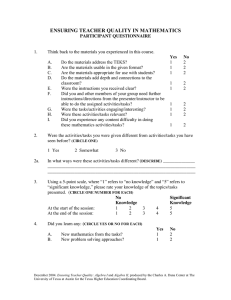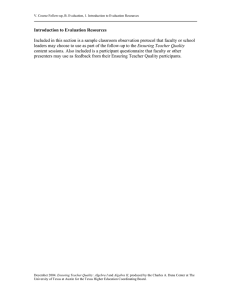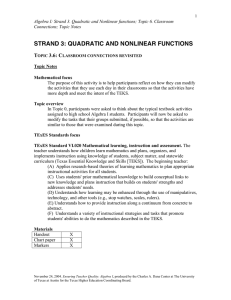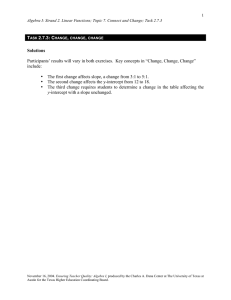II. OVERVIEW FOR THE FACILITATOR
advertisement
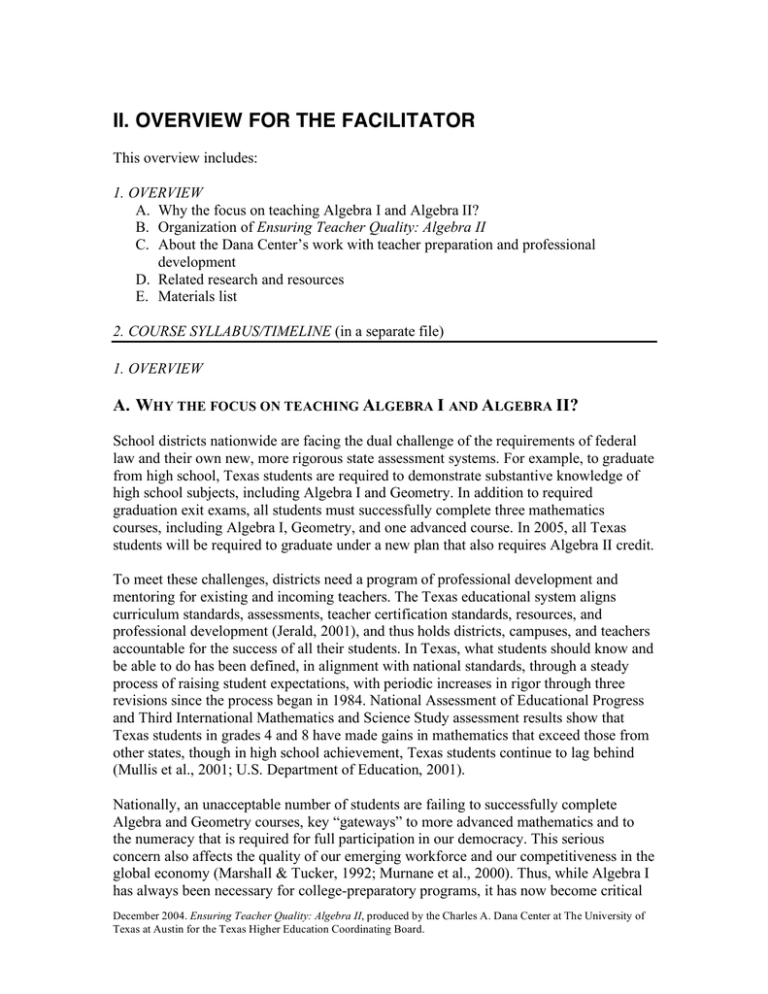
II. OVERVIEW FOR THE FACILITATOR This overview includes: 1. OVERVIEW A. Why the focus on teaching Algebra I and Algebra II? B. Organization of Ensuring Teacher Quality: Algebra II C. About the Dana Center’s work with teacher preparation and professional development D. Related research and resources E. Materials list 2. COURSE SYLLABUS/TIMELINE (in a separate file) 1. OVERVIEW A. WHY THE FOCUS ON TEACHING ALGEBRA I AND ALGEBRA II? School districts nationwide are facing the dual challenge of the requirements of federal law and their own new, more rigorous state assessment systems. For example, to graduate from high school, Texas students are required to demonstrate substantive knowledge of high school subjects, including Algebra I and Geometry. In addition to required graduation exit exams, all students must successfully complete three mathematics courses, including Algebra I, Geometry, and one advanced course. In 2005, all Texas students will be required to graduate under a new plan that also requires Algebra II credit. To meet these challenges, districts need a program of professional development and mentoring for existing and incoming teachers. The Texas educational system aligns curriculum standards, assessments, teacher certification standards, resources, and professional development (Jerald, 2001), and thus holds districts, campuses, and teachers accountable for the success of all their students. In Texas, what students should know and be able to do has been defined, in alignment with national standards, through a steady process of raising student expectations, with periodic increases in rigor through three revisions since the process began in 1984. National Assessment of Educational Progress and Third International Mathematics and Science Study assessment results show that Texas students in grades 4 and 8 have made gains in mathematics that exceed those from other states, though in high school achievement, Texas students continue to lag behind (Mullis et al., 2001; U.S. Department of Education, 2001). Nationally, an unacceptable number of students are failing to successfully complete Algebra and Geometry courses, key “gateways” to more advanced mathematics and to the numeracy that is required for full participation in our democracy. This serious concern also affects the quality of our emerging workforce and our competitiveness in the global economy (Marshall & Tucker, 1992; Murnane et al., 2000). Thus, while Algebra I has always been necessary for college-preparatory programs, it has now become critical December 2004. Ensuring Teacher Quality: Algebra II, produced by the Charles A. Dana Center at The University of Texas at Austin for the Texas Higher Education Coordinating Board. II. Overview for the Facilitator 2 for all students. In Texas’s current accountability environment, algebra concepts are at the heart of increasingly more rigorous student assessments in grades 7–8. With previous school improvement efforts focused primarily on K–8, new requirements for a welldefined Algebra course—as well as for a now-mandatory Algebra II course in high school—have come so quickly that few districts, and in particular few districts that serve high-minority and economically disadvantaged populations, have built the capacity to reliably prepare their students to meet the challenges presented by higher expectations (Massell, 1998). The Ensuring Teacher Quality: Algebra II resources include materials for trainers and for teachers that will support enhanced day-to-day classroom instruction—especially for teachers who are underprepared and underqualified—in a way that ensures positive results for the majority of students, especially those in high-needs districts. For maximum effect, these materials should be offered as part of a sustained, intensive, comprehensive teacher training program that is grounded in the Texas Essential Knowledge and Skills (TEKS), builds capacity of administrators and campus and district leaders to support teachers, and is directed toward student learning and achievement on the Texas Assessment of Knowledge and Skills (TAKS). B. ORGANIZATION OF ENSURING TEACHER QUALITY: ALGEBRA II I. Front Matter (including Table of Contents) II. Overview for the facilitator (this section). There is also a Course Syllabus in a separate file. III. State standards and objectives The Texas Essential Knowledge and Skills (TEKS) are the Texas curriculum standards that delineate what students should know and be able to do in each mathematics course. Algebra I and Algebra II TEKS, adopted by the Texas State Board of Education, are included in this section. The Texas Assessment of Knowledge and Skills (TAKS) is one of the measures used in the statewide accountability system. TAKS objectives test the knowledge and skills named in the TEKS. All students are tested in mathematics in grades 3– 10, with an 11th-grade exit exam required for graduation. The high school mathematics TAKS tests students on Algebra I and Geometry, as well as probability and statistics and problem solving. TAKS objectives are listed in this section for grades 9, 10, and exit. For online information about the Texas accountability system, TEKS, or TAKS, see the Texas Education Agency’s website, www.tea.state.tx.us. The Texas Examinations of Educator Standards (TExES) is the teacher certification test based on the State Board for Educator Certification standards. December 2004. Ensuring Teacher Quality: Algebra II, produced by the Charles A. Dana Center at The University of Texas at Austin for the Texas Higher Education Coordinating Board. II. Overview for the Facilitator 3 This section includes TExES standards for mathematics teachers for grades 8–12. For more information, see the TExES website, www.texes.nesinc.com/. The State Board for Educator Certification standards build from the TEKS as a starting point for what teachers should know and be able to do in order to teach students well. For more information, refer to the State Board for Educator Certification website, www.sbec.state.tx.us, and in particular the standards section of the site, www.sbec.state.tx.us/SBECOnline/standtest/edstancertfieldlevl.asp. IV. Course content The course content is divided into four main areas—an introduction that sets the context, the actual course content, related resources, and a pre/post test (and key) for evaluation. A. Introduction The course introduction includes information on: Problem solving throughout the course Support for struggling students Technology use in mathematics A list of references cited appears at the end of each part. B. Course content Each course is divided into content strands that consist of topics (with topic notes) and, under each topic, tasks, with each task including task notes followed by the actual task. Content strands match the TEKS strands for Algebra I and the Scope and Sequence strands for Algebra II. Each content strand contains several topics. For each of the tasks, the organizing structure is Task #1 Notes, Task #1; Task #2 Notes, Task #2, and so on, so that all the materials needed for each task are together. Tasks are numbered in order whether they are intended for course participants (teachers) or for high school students. Learning to decide which tasks are appropriate for students and how to modify those that are not appropriate is a part of the course experience for teachers; therefore, the tasks are not always labeled “for students” or “for participants.” Strand December 2004. Ensuring Teacher Quality: Algebra II, produced by the Charles A. Dana Center at The University of Texas at Austin for the Texas Higher Education Coordinating Board. II. Overview for the Facilitator This is the broad subject being addressed. For example, Foundations of Functions is a strand in Algebra II. The strand is then further divided into topics. Topic Each topic is a section within the strand. For example, a topic within the Foundations of Functions strand might be Transformations. Topic notes cover the entire section—the topic and related tasks. Topic notes include: Mathematical focus Topic overview TExES standards focus TEKS/TAKS standards focus Materials needed Procedure for presenting the tasks Summary of the topic Extension activities, assessments, and transition to the classroom suggestions, as well as additional notes, when needed. Task Each task falls under a topic and is designed to: Lead participants or students through the material in the topic Be hands-on and interactive—many tasks require group work, manipulatives, and technology Include a master copy of handouts for students and a version with answers and explanations C. Related Resources This list includes descriptions of additional resources that may be helpful to faculty, course facilitators, or teachers. D. Pre/Post-Test A Pre/Post Test and Key are included as evaluation resources for trainers to use with participants. V. Course Follow-up This section contains resources for following up after the course. December 2004. Ensuring Teacher Quality: Algebra II, produced by the Charles A. Dana Center at The University of Texas at Austin for the Texas Higher Education Coordinating Board. 4 II. Overview for the Facilitator 5 A. Leader’s Resource Guide The protocols and presentation materials in the Leader’s Resource Guide are designed for use by trainers with campus or district administrators, teacher leaders, campus mentors, and, most importantly, classroom teachers (especially novice or uncertified teachers) to help them follow up and support TEKS-based professional development and coursework. Activities involve campus and district leaders in setting expectations and providing teacher support so that what teachers learn about content and pedagogy will improve their instruction, including understanding the Algebra II TEKS and high school TAKS expectations. The materials are designed around proven strategies, such as collaborative teacher examinations of student work. Included in this section are: an introduction to the Leader’s Resource Guide; a section to share research findings from Improving Algebra I End-ofCourse Exam Scores: Evidence from the Field (Dana Center, 2000); resources for understanding the format of the TEKS; information for understanding the programmatic nature of the TEKS; a guide for working with teachers to learn about practice from examining student work; and a references list. B. Evaluation This section includes a classroom observation protocol for faculty or other trainers to use in observing teachers as a follow-up to the coursework. Also included is a participant questionnaire. C. ABOUT THE DANA CENTER’S WORK WITH TEACHER PREPARATION AND PROFESSIONAL DEVELOPMENT The Ensuring Teacher Quality project builds on other Dana Center work in higher education and teacher preparation, most notably the work of a statewide network of Texas faculty. For the past decade, the Dana Center has organized higher education networks and involved faculty from across Texas in our annual higher education conferences, the October Preservice Conference and the Mathematics Higher Education Symposium (formerly known as University Forum). The October conference focuses on the preparation of preservice mathematics teachers, while the Symposium was the vehicle through which mathematics institutes and other professional development opportunities were shared with higher education faculty involved in the mathematical preparation of teachers and in work with inservice teachers. These conferences have helped form networks for university and public school faculty from across the state, and fostered consensus around critical content and pedagogical issues in mathematics education. They have also led to the publication of two substantial December 2004. Ensuring Teacher Quality: Algebra II, produced by the Charles A. Dana Center at The University of Texas at Austin for the Texas Higher Education Coordinating Board. II. Overview for the Facilitator 6 books of resources and recommendations for standards-based, content-driven preparation of mathematics teachers, Guidelines for the Mathematical Preparation of Prospective Elementary Teachers (1996) and Supporting and Strengthening Standards-based Mathematics Teacher Preparation: Guidelines for Mathematics and Mathematics Education Faculty (2004), which provides TEKS- and SBEC-standards-aligned resources for the mathematical preparation of teachers of early childhood–grade 4, grades 4–8, and grades 8–12. In addition to its higher education work, the Dana Center also managed—and developed new materials for—the statewide comprehensive system of professional development for mathematics and science teachers, Texas Teachers Empowered for Achievement in Mathematics and Science (TEXTEAMS). The program’s mathematics institutes provide a core set of professional development materials and skills that help teachers develop a common understanding of important mathematics content and the TEKS. The institutes also model effective instructional and questioning strategies, and, through teacher examination of student work, promote reflective dialog about effective teaching strategies. For education leaders, especially principals, the Dana Center created TEKS for Leaders, a series of professional development seminars on issues surrounding successful implementation of the Texas Essential Knowledge and Skills and improved student achievement, particularly in mathematics. The Partnership for High Achievement is the Dana Center’s district-centered initiative that grew out of what we learned from the strengths and weaknesses of the above projects, and from a recent Dana Center study (Holcombe, Schneider, and Myers, 2003) that found, based in part on a literature review, that the constituent elements of a coherent and effective strategy for professional development include the use of common instructional strategies and assessments, a coordinated curriculum, and professional development that supports the implementation of all these. The study also found that such a strategy for professional development should also include teacher accountability, collaboration between teachers, and sustained implementation measures. Based on these findings and others, the Dana Center in 2003 launched the Partnership for High Achievement. The PHA integrates our professional development and district support services with our research and resources for strengthening mathematics and science achievement. For more information, see the Dana Center’s website, www.utdanacenter.org. December 2004. Ensuring Teacher Quality: Algebra II, produced by the Charles A. Dana Center at The University of Texas at Austin for the Texas Higher Education Coordinating Board. II. Overview for the Facilitator 7 D. RELATED RESEARCH AND RESOURCES Charles A. Dana Center. (2003). Advanced mathematics educational support: Support, recommendations, and resources for facilitating collaboration between higher education mathematics faculty and Texas public high schools. Charles A. Dana Center, University of Texas at Austin. Charles A. Dana Center. (1996). Guidelines for the mathematical preparation of prospective elementary teachers. Charles A. Dana Center, University of Texas at Austin. Charles A. Dana Center. (2004). Supporting and strengthening standards-based mathematics teacher preparation: Guidelines for mathematics and mathematics education faculty. Charles A. Dana Center, University of Texas at Austin. Cohen, D. K., & Ball, D. L. (2000). Instructional innovation: Reconsidering the story. Ann Arbor: The University of Michigan. Cohen, D. K., & Ball, D. L. (1999). Instruction, capacity, and improvement (CPRE Research Report Series No. RR-43). Philadelphia: Consortium for Policy Research in Education, University of Pennsylvania Graduate School of Education. Cohen, D. K., Raudenbush, S. W., & Ball, D. L. (2000). Resources, instruction, and research. Seattle: Center for the Study of Teaching and Policy, University of Washington. Retrieved September 2, 2003, from http://depts.washington.edu/ctpmail/Abstract-RIR.html. Darling-Hammond, L. (2000). Reforming teacher preparation and licensing: Debating the evidence. Teachers College Record, 102(1), 28–56. Hall, G. E., & Hord, S. M. (2001). Implementing change: Patterns, principles, and potholes. Boston: Allyn & Bacon. Holcombe, L. (2002). Teacher professional development and student learning of Algebra: Evidence from Texas. Unpublished doctoral dissertation, Cambridge, MA: Harvard University. Holcombe, W. L., Schneider, C. L., & Myers, M. (2003). The Charles A. Dana Center’s TEXTEAMS Professional Development Model: Evidence for effectiveness. Charles A. Dana Center, University of Texas at Austin. Ingersoll, R. M. (2001). Teacher turnover, teacher shortages, and the organization of schools. Seattle, WA: Center for the Study of Teaching and Policy, University of Washington. December 2004. Ensuring Teacher Quality: Algebra II, produced by the Charles A. Dana Center at The University of Texas at Austin for the Texas Higher Education Coordinating Board. II. Overview for the Facilitator 8 Jerald, C.D. (2001, April). Real results, remaining challenges: The story of Texas education reform. Washington, D.C.: The Business Roundtable and The Education Trust. Available: www.businessroundtable.org/publications/index.aspx (122104) scroll down to the date 4.19.01 Marshall, R. & Tucker, M. (1992). Thinking for a Living: Education and the Wealth of Nations. New York: Basic Books. Massell, D. (1998). State strategies for building local capacity: Addressing the needs of standards-based reforms. Philadelphia, PA: Center for Policy Research in Education, University of Pennsylvania. Mullis, I. V. S., Martin, M. O., Smith, T. A., Garden, R. A., et al. (2001). TIMSS assessment frameworks and specifications 2003. Chestnut Hill, Boston College. Murnane, R. J.; Willet, J. B.; Duhaldeborde, Y.; Tyler, J. H. (2000, Fall). How important are the cognitive skills of teenagers in predicting subsequent earnings? Journal of Policy Analysis and Management, 19(4), 547–68. Sargent, B. W. (2003). The effects of a TEXTEAMS professional development institute on teachers’ proportional reasoning. Unpublished master’s thesis, University of Texas at Austin. Texas State Board for Educator Certification. (2002). Texas beginning educator support system: Evaluation report for year three: 2001–02. Austin, TX: Author. Available for download from http://www.sbec.state.tx.us/SBECOnline/txbess/evalrpt.asp. U.S. Department of Education, Office of the Under Secretary, Planning and Evaluation Service, Elementary and Secondary Education Division. (2000). Does professional development change teaching practice? Results from a three-year study, Executive summary. Washington, DC: Author. U.S. Department of Education, Office of Educational Research and Improvement, National Center for Education Statistics. (2001). The Nation's Report Card: State Mathematics 2000, Report for Texas, NCES 2001-519 TX, by C. Solomon, L. Jerry, and A. Lutkus. Washington, DC: USDOE. Yañez, D. A., & Wenrick, M. (2000). Improving Algebra I End-of-Course Exam scores: Evidence from the field. Austin, TX: Charles A. Dana Center, University of Texas at Austin. December 2004. Ensuring Teacher Quality: Algebra II, produced by the Charles A. Dana Center at The University of Texas at Austin for the Texas Higher Education Coordinating Board. II. Overview for the Facilitator E. MATERIALS LIST This list summarizes the materials that will be needed to complete this course content. It is not intended to replace the more detailed materials lists that can be found at the beginning of each topic. Overhead projector Overhead calculator viewing screen or comparable device Graphing calculator (teacher model) Motion detectors (class set) Pattern blocks (class set) Colored paper (at least two colors) Card stock paper (for templates) Graphing calculator Patty paper Wall chart paper Flip chart with ruled squares Metersticks Masking tape Graph paper Transparencies (several boxes for copies, in-class use, etc.) Transparency pens Poster markers Basketball or racquetball String Washers Timers Tape measures Compass Scissors Colored pencils Conics APP for TI-83 Plus Program CONIC for TI-83 Plus Program CONICSTU for TI-83 Plus December 2004. Ensuring Teacher Quality: Algebra II, produced by the Charles A. Dana Center at The University of Texas at Austin for the Texas Higher Education Coordinating Board. 9
